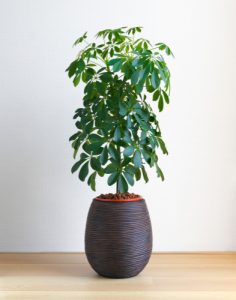Indoor plants are the new pets, and almost every social media account features photos of lush, gorgeous indoor plants. But not every indoor plant is as fickle and scary as to handle as the fiddle leaf fig. Not every indoor plant needs extensive gardening experience or a natural green thumb. We have put together a list of hardy indoor plants that can survive and thrive despite serious neglect. These plants are the 25 best indoor plants that are almost impossible to kill.
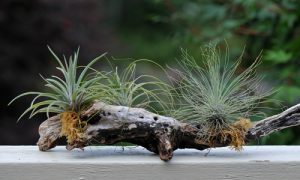
1: Air Plant
Air plants are stunning, otherworldly plants that grow on just air, without any soil required. These beautiful plants have become quite popular over the last few years, appearing in almost every garden center, and even in checkout lines at the grocery store. Air plants are epiphytes, meaning they grow on other plants in nature, usually on tree branches. Air plants are easy to care for. They don’t need to be potted but they do need a certain amount of water and light, as well as the right temperature, like any other houseplant. You’ll know that your air plant is getting what it needs when it blooms. Keep your air plants out of direct sunlight, as they prefer sheltered, dappled shade.
While an air plant doesn’t have roots like normal plants, the do have small ones meant to hold onto whatever surface they’ve attached to. You will need to water your air plant about once a week though some varieties can go two weeks without being watered. Place them in a sink or a small jar with enough water to submerge your plant. Let it soak for at least half an hour. Give them a gentle shake and leave them upside down on a towel to drain. Then return them to their designated spot. Air plants love warm weather so protect them from temperatures 7°C and colder.
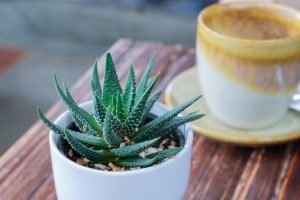
2: Aloe
Aloe is an extremely popular plant, featured all over social media, and for good reason. This hardy succulent is not only attractive, it is also useful for home remedies to treat minor burns and rashes. And like other succulents, aloe does well in dry conditions. When growing aloe vera, they are best planted in a cactus potting mix or a regular soil that has building sand and perlite mixed into it. It is important that you have a pot with good drainage as aloe can’t tolerate standing water. They also need bright light, so they do well in bright windows.
When watering your plant, you should allow the soil to go completely dry between waterings. When watering, the soil should be thoroughly drenched and allowed to drain freely from the soil. The most common reason an aloe plant dies is overwatering and no drainage. This hardy plant won’t need fertiliser but if you want to, you can use a phosphorous-heavy, water-based fertiliser at half strength.
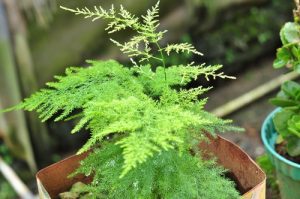
3: Asparagus Fern
Asparagus ferns are beautiful, frilly, feathery plants that appear soft and fuzzy. But be careful! When taking care of your asparagus fern you will find these are actually little thorny spurs. But don’t let that stop you from growing this pretty, quirky plant – you simply need to wear gloves when caring for your asparagus fern. When the fern is happy in its location it can actually produce small flowers and berries. The berries can be planted to propagate more plants. It’s green, cascading foliage will quickly fill a container, allowing it to cascade beautifully in hanging pots. It prefers a part sun to shady location for the best looking foliage.
When keeping your asparagus fern inside does take a little more effort. You will need to provide the plant with proper humidity as indoor areas are often too dry because of winter heating. You will need to mist your plant daily and provide a nearby pebbly tray to keep the leaves from turning brown and dropping. Your fern might dry out to the point it appears dead, however, outdoor springtime temperatures generally revive them. Keep your plant well watered in all situations and repot it every few years. These plants prefer to be pot bound, so yearly division is not needed. Prune out dead stems and provide a little fertiliser in the summer to encourage growth.
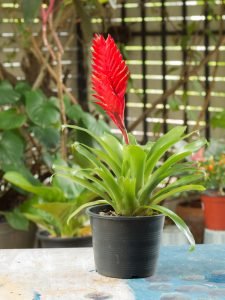
4: Bromeliad
While bromeliads look high maintenance, these unusual looking plants are easy to care for. They are prized for their thick foliage that grows in a natural rosette and, by the end of its life, the bromeliad plant can produce a flower. This flower widely varies among each variety of bromeliad. The wide, sword-shaped leaves grow around a central cup that catches water. Like air plants, bromeliad plants are often epiphytic and cling to trees or other structures to gather sun and moisture. These plants are widely available in garden centres and nurseries, like Aumann’s Garden Supplies. They prefer medium to bright light and don’t need deep pots or thick porting soils. Bromeliads do even better in shallow pots and grow in orchid mixes, bark blends, sphagnum moss, and other organic soils.
Bromeliads don’t need special tools, care, or fertilisers. They need a half strength fertiliser every month during the growing season. Water by filling the cup at the base of the leaves. The water that collects in the pot should be emptied out weekly to remove debris and dead insects. Set your plant’s pot in a saucer of gravel filled partially with water to increase humidity and help provide a moist atmosphere. Prevent root rot by ensuring the root are not submerged in the water.
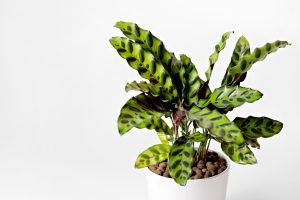
5: Calathea
In their natural habitat, the colourful calathea leaves are used for handicraft and food wrapping. Because of the wide range in leaf shapes and colours, they are also popular houseplants and their popularity is only growing. Calathea thrives in medium to bright, indirect light but will also tolerate low indirect light. It prefers to be watered every 1-2 weeks, allowing the soil to dry out halfway down between waterings. If you plant is sitting in brighter light, expect it to need water more than plants kept in lower light.
As a tropical plant, calathea prefer a higher humidity where possible. You might want to consider incorporating a fine-mist mister or a humidifier to boost the humidity levels indoors and keep your plant happy. Most calathea prefer indoor temperatures between 18-30°C. It is best not to let the temperature drop beneath 15°C if possible. Where possible, use a well-draining potting mix.
Calathea are an easy-going plant and generally pest free. Treat pests as soon as they appear with weekly sprays of natural pesticides like neem oil, and regularly wipe down the plant. The calathea is pet friendly but it is best to keep them out of reach of small children and overly curious pets.
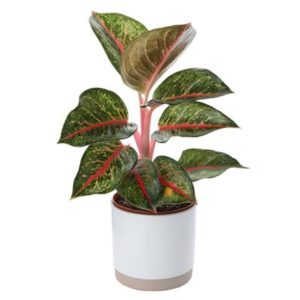
6: Chinese Evergreen
Growing a Chinese evergreen is incredibly easy. It is one of the most popular houseplants and comes in a number of varieties. They can tolerate many growing conditions but they prefer a well-draining soil, preferably an equal mix of potting soil, perlite, and sand. They thrive in medium to low light conditions or indirect sunlight. Wherever you place your Chinese evergreen, you should ensure the plant receives warm temperatures and somewhat humid conditions, but they will tolerate less than ideal conditions if necessary. These evergreens prefer temperatures no lover than 16°C with ideal temperatures between 20-22°C. keep them away from drafts, which can cause the foliage to brown.
Your Chinese evergreen prefers moderate watering – not too much and not too little. Allow the plant to dry out somewhat between watering. Overwatering your plant could lead to root rot. You should also fertilise older Chinese evergreens one or twice a year with a water soluble houseplant fertiliser. If your plant becomes too large or leggy, it is time to give the plant a quick trim. You can save cuttings during the pruning process to propagate new plants. Older plants will also sometimes produce flowers reminiscent similar to calla or peace lilies in spring to summer. Clean the dust build up off the leaves with a soft, damp rag or place them in a soft shower and then let them airdry.
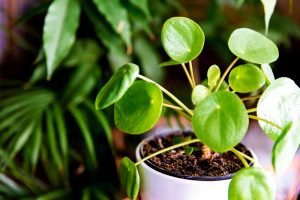
7: Chinese Money Plant
Also known as the Pilea, the Chinese Money Plant is perfect for Scandinavian style interiors where its bright green, pancake-shaped leaves that provide a beautiful burst of colour against white walls. These easy to grow plants prefer bright light with no direct sunlight. Direct sunlight can scorch leaves, while light shade can encourage larger leaves to grow. They are hardy against freezing and periods of cool temperatures make them more likely to produce tiny white flowers on pink stems.
The Chinese money plant prefers well-draining potting soil, and you must use a pot with drainage holes. Make sure the soil dries out between waters, with more water required in warmer, sunnier weather. If the leaves are starting to look a little droopy, that’s a sign that the money plant needs water. To keep your plant nicely in shape, make sure you rotate it regularly to prevent it from getting lopsided. The larger leaves will gather dust so they benefit from regular showers or wiping down. In spring and summer they like an all-purpose plant fertiliser.
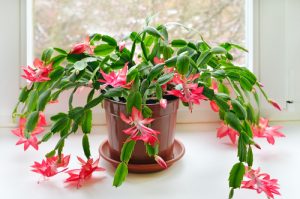
8: Christmas Cactus
Also know as the Thanksgiving cactus or Easter cactus, the Christmas cactus is a popular, winter-flowering indoor plant that makes a great addition to nearly any indoor setting. It is easy to take care of and makes a great option for gift giving. It can thrive under average home conditions with moderate care. They adapt well to low light conditions but will bloom more readily if exposed to brighter light. Too much direct sunlight, however, can burn its leaves, so keep the cactus in an appropriate area to avoid this. Moisture leave is important as well. It requires frequent and thorough watering during its active growing period over spring and summer, so keep the soil slightly moist. Allow Christmas cactus moisture levels to drop and dry out between waterings but never completely, and never let the plant sit in water, as this will lead to root and stem root. Apply a mild houseplant fertiliser every other week.
The Christmas cactus prefers temperatures between 15-21°C with average to high humidity levels. Place a tray of pebbles filled with water beneath the Christmas cactus to add more humidity to the home and around your cactus. Keep your cactus away from drafty areas to prevent it getting too could or the cactus browning.
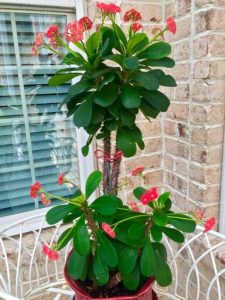
9: Crown of Thorns
Heat tolerant and drought tolerant, the crown of thorns is an easy to grow indoors, making it a real gem for beginner plant owners. This unique houseplant is one of the few succulents with real leaves – thick, fleshy, and tear shaped. These leaves grow on steams that are armed with sharp, inch-long spines. Grown properly, the plant also offers a mass of delicate blossoms all year round.
Place your crown of thorns in a sunny window where it will receive three to four hours of direct sunlight each day. It prefers average room temperature of 18-24°C but it can withstand temperatures as low as 10°C and as high as 32°C. water by flooding the crown of thorns with water. After all the excess water has drained through, empty the saucer under the pot so the roots aren’t left sitting in water. In winter, allow the soil to dry to a depth of 2-3 inches before watering. The crown of thorns likes to be fed a liquid houseplant fertiliser every 2 weeks in spring, summer, and autumn. In winter, dilute the fertiliser to half strength and use monthly. Repot your cactus every 2 years in later winter to early spring. The crown of thorns needs a potting soil that drains quickly and is designed for cacti and succulents. A pot that is large enough to accommodate the roots, and always wear gloves when working with crown of thorns. The plant is poisonous if eaten and the sap causes skin irritation.
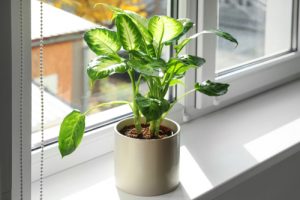
10: Dieffenbachia
The dieffenbachia is large and showy, making it the perfect living decoration for your home or office. It is easy to care for and incredibly adaptable to different kinds of lighting and conditions. Overwatering is one of the most common problems for houseplants and the dieffenbachia is no different. You need to plant it in a well-draining soil and water lightly, keeping the soil consistently moist but not soggy. Check the soil to make sure it is dray about an inch down before watering the plant.
Dieffenbachia prefer filtered light, where bright light shines through a sheer curtain or window cover. Ensuring the plant has filtered light is the most important in summer and spring when the plant is producing new, tender leaves that can be subject to sunburn if the light is too bright or shines directly on the plant. Rotating the dieffenbachia regularly to ensure all sides of the plant get adequate sunlight prevents it from becoming lop-sided. Fertilise twice a month to encourage growth, as well as a healthy plant.
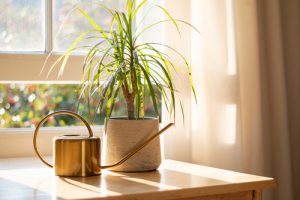
11: Dragon Tree
The dragon tree is an elegant, sub-tropical plant with strappy foliage and a long stem that makes them ideal for tight spots in your home. It is a fantastic choice for beginner plant owners. Dragon trees prefer bright, indirect light. If they get too much sun, the leaves are at risk of being scorched. They are best grown in bathrooms or kitchens where they benefit from the humidity. These hardy plants prefer underwatering to overwatering, so let the top few centimetres of soil dry out before watering again.
Dragon trees like a free-draining, potting compost with added grit, but make sure you keep an eye on it and water the plant when it dries out. Your plants prefer temperatures between 18-32°C, and you should ensure the plant isn’t exposed to temperatures below 15°C in winter. Feed your Dragon tree fortnightly in the summer using a balanced liquid feed at half strength.
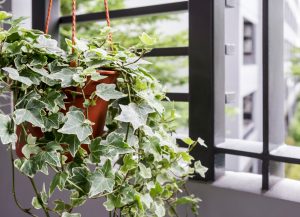
12: English Ivy
English ivy is an elegant, easy to care for plant that looks as stunning indoors as it does outdoors. There is very little you need to do to care for this pretty ivy species. English ivy prefers a shady area with an organically rich soil. They look gorgeous inside grown up a trellis, stake or other growing structure or in hanging baskets. You can even grow them on a shaped wire frame to create a topiary design.
English ivy needs to be watered often enough to keep the soil moist until the plants are established and growing well. These vines grow best when they have plenty of moisture, but they tolerate dry conditions once the plants have established.
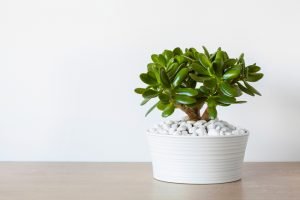
13: Jade Plant
Jade plants are fantastic indoor plants for beginners because their care is easy and simple. They are ideal for homes and offices, and are also considered to be symbols of good luck! The most important aspect of jade plant care is to make sure they are watered properly. Never let your plant dry out completely, though but don’t water too often, as this can cause root rot. It is best not to try and water your plant on a schedule. Instead, water when the top of the soil is just dry to the touch. If you are noticing it is losing leaves or have leaf spots, it is getting to little water. Sunlight requirement is another important aspect of the care and maintenance of your jade plant. Jade plants need full sun in order to grow properly. When they don’t have full sun, these plants can become stunted and leggy.
Jade plants do best in temperatures in 18-24°C and those that are getting full sunlight will do well in temperatures even higher than this. They also do well in night temperatures of 10-13°C. jade plants need a balanced, water-soluble fertiliser, once every 6 months. You should water your plant normally first then water it with the fertiliser. Never fertilise your plant when the soil is dry as this will damage the roots.
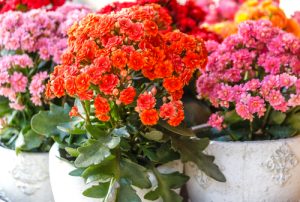
14: Kalanchoe
These beautiful thick leaf succulents are seen in florists and garden centres. They are ideal potted plants but can be grown outdoors. Kalanchoe feature clusters of tiny flowers that produce a large bloom held on stems above the foliage. This succulent has gorgeous, dark green, scalloped leaves that are just as attractive as the flowers. Its sculpted look makes it popular with homeowners as it provides a beautiful, eye catching look in any room. The starry flowers are long-lasting and bloom from winter to spring.
Kalanchoe need well-drained soil and mild temperatures of at least 16°C. There is little maintenance necessary when it comes to caring for your kalanchoe plant as it has few diseases or pest problems. This succulent prefers partial sun to light shade areas as strong light can burn the tips of the leaves. It grows best in a plant mix of 60% peat moss and 40% perlite. Always cut off spent flower stems and leggy growth to keep the plant compact. The kalanchoe likes to be watered deeply and needs the soil to dry out completely between watering. Fertilise once per month with a houseplant food during the growing season.
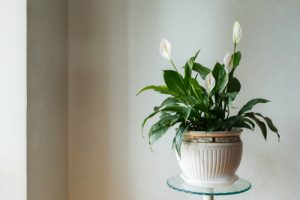
15: Peace Lily
Peace lilies are a popular choice for offices, home offices, and around the home. They are one of the easiest plants to care for, making them perfect for beginners. These are gorgeous plants that not only brighten your space but also clean the air of the room they are placed in. they have dark green leaves and distinctive white flowers. Peace lilies enjoy medium to low light – place your lily in more light for flowers, and in less light if you only want to enjoy the dark green foliage of the plant. They are also far more tolerant of underwatering than overwatering which is one of the common reasons why a peace lily could die. Don’t water your peace lily on a schedule. Instead, check them once a week to see if they need to be watered. Simply touch the top of the soil to see if it Is dry. If the soil is dry, you can water your lily. If the soil is still moist, your plant doesn’t need watering.
Peace lilies don’t need frequent fertilising. But you can fertilise one or two times a year with a balanced fertiliser to keep the lily happy. These plants also benefit from repotting or dividing when they outgrow their container. If the plant is drooping less than a week after being watered, and the leaf growth is crowded and deformed, it is time to divide the plant up and repot. Peace lilies prefer a pot that is at least 2 inches larger than its current pot. The wide leave on the peace lily tend to be a dust magnet, so you need to shower the plant or wipe down the leaves at least once a year. By keeping the leaves dust free, the plant can process sunlight better.
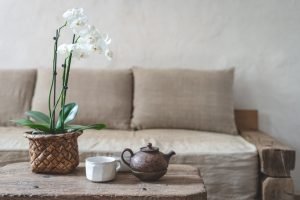
16: Phalaenopsis Orchid
Phalaenopsis orchids – also known as moth orchids – are broad-leafed plants with long-lasting blooms that are flat and showy. The flowers last maybe 2-3 months and are considered one of the easiest orchids to grow. A rule of them is the wider the leaf span, the more blooms you can expect from the orchid. Phalaenopsis orchid prefers diffused or low light situations and prefers 18-24°C during the day, and no more than 10 degrees lower at night. Broad spectrum fluorescent lights can be used for successfully growing phalaenopsis orchids.
A phalaenopsis orchid should not be planted in regular potting soil as the roots will suffocate and will rot away. It is better to grow them in a coarse textured mixture or you can make your own mix from coarse fir bark, charcoal, perlite, and coarse peat moss. This mixture should remain moist, only drying slightly between watering, but never drying out completely. High humidity is necessary for optimum growth of your orchid. It needs between 50-80% humidity in order to thrive. This can be done using a room humidifier, a pebble tray beneath the orchid, and misting.
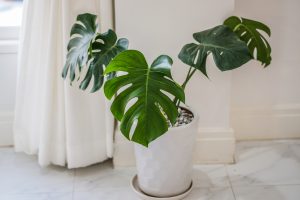
17: Philodendron
Philodendrons have long served as a mainstay for the beginner indoor gardener. These plants are easy to care for because, as long as you watch for the signals, the plant will tell you exactly what it needs. Even if this is your first time growing a plant, you will have no issues with a philodendron as it readily adapts to its environment. Ensuring the you wipe down the leaves of the plant with plenty of fresh water to allow them better absorb sunlight. Philodendrons like bright, indirect sunlight so position it near a window where the sun’s rays never actually touch the foliage. While it’s normal for older leave to grow yellow, if it is happening to several leave at the same time, the plant might be getting too much light. But if the plant is getting long and leggy, it isn’t getting enough light.
Let the top inch of soil to dry out between waterings. Drooping leaves can mean the plant is getting too much or not enough water. But philodendrons recovery quickly once you correct your watering schedule. Feed the plant fertiliser once a month in spring and summer, and every 6-8 weeks in fall and winter. It should be a balanced foliage houseplant fertiliser with macro-nutrients.
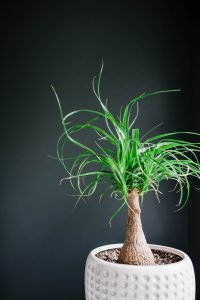
18: Ponytail Palm
The ponytail palm is another plant that is growing in popularity. Its sleek, bulb-like trunk, and lush, long, curly leaves make it visually stunning. It is also a highly forgiving and easy to care for, making it ideal for beginners. Surprisingly, this plant isn’t actually a palm, but a large form of succulent! It needs bright light but, as a forgiving plant, it will be okay if it only gets bright light half the time. In fact, you can keep the palm in low light for half the year, and in full light for the other half. For example, you can keep the plant outdoors in summer, then bring it indoors for winter – if you don’t have a good location indoors where the palm will get full sun. And since this plant is a succulent it grows best in semi-dry conditions. So when watering your ponytail palm, let the soil dry out between waterings.
Ponytail palms prefer to be rootbound in dry soil so when you repot, make sure the new pot is only an inch or so wider than the old pot. They only need to be fertilised 2-3 times a year – any more than this and they may develop brown tips on the leaves.
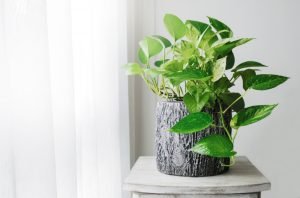
19: Pothos
The pothos is the houseplant for beginners. This plant is easy and undemanding, making it a great way to add some green to your home. These hardy little plants enjoy a wide range of environments. They do well in bright, indirect light as well as low light and can be grown in dry soil – as well as in vases of water. They thrive in nutrient rich soil but also do just as well in nutrient poor soil. Pothos make great bathroom and office plants because they can tolerate low light. The only thing a pothos can’t tolerate is direct sunlight. They can also stand moderate periods of dry soil with little effect to the plant. Fertilise once every 3 months to help your plant grow more quickly.
One thing to remember is that pothos plants are poisonous. Though they are rarely fatal, the plant can cause irritation and vomiting if eaten because it contains calcium oxalates. Even the sap can cause highly sensitive skin to break out in a rash. It is considered highly toxic to cats, dogs, and children; it will make them very sick but is unlikely to kill them.
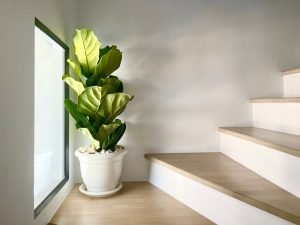
20: Rubber Plant
Also known as a Ficus elastica, these large trees can grow up to 50 feet tall. There are a few key things to remember when caring for rubber plants, but they are still incredibly easy to care for. It is important to start with a young rubber plant if you are keeping it inside, as it will adapt better to being an indoor plant than a mature plant. Your rubber plant needs bright light but prefers indirect light that isn’t too hot. Some people recommend putting it near a window that has sheer curtains. This allows plenty of light but not too much heat.
Rubber plants also need the right balance of water. It needs to be kept moist and watered at least once a week during their growing season. It is also important to wipe off the leave of your rubber plant with a damp cloth or spritz them with water. When the plant is dormant, it only needs to be watered once or twice a month.
21: Schefflera
The Schefflera is a highly popular plant and comes in many varieties. They most well-known is the umbrella tree. Schefflera are popular because it is so easy to care for and keep healthy and lush. These plants prefer medium light, meaning they need bright but indirect light. If your schefflera is getting leggy and floppy, it means it isn’t getting enough light. And bright, direct light can burn the leaves, so make sure you place your plant carefully. Watering correctly is also important to keep your schefflera happy and healthy. Wait until the soil in the pot dries out and then thoroughly soak the soil when you water. Don’t overwater as this will eventually kill it. If the leaves are getting yellow and falling off, this is a sign you are watering too much.
Pruning your schefflera is important, especially if it isn’t getting enough light. Pruning is simple. Just cut off anything you feel is overgrown or leggy back to the size or shape you like. These plants quickly rebound from pruning and will grow fuller and more lush after pruning. You don’t need to fertilise your schefflera but if you want to, you can give it a half solution water soluble fertiliser once a year. These plants are poisonous to both people and animals if eaten. While not fatal, it will cause a burning sensation, swelling, difficulty swallowing and, in some cases, difficult breathing.
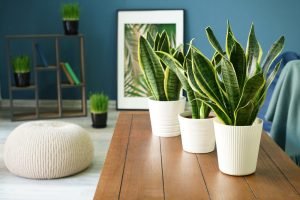
22: Snake Plant
One of the most tolerant houseplants, the snake plant is the perfect option for beginner indoor gardeners. Caring for this beautiful plant is straightforward. They can be neglected for weeks at a tome but still look fresh. Snake plants can survive at low light levels, through drought, and have few pest problems. And even better, NASA research has shown that snake plants are able to help keep the air inside the home clean, removing toxins from the air, including formaldehyde and benzene.
Snake plants are happy in indirect sunlight and don’t need too much water, especially during winter. In fact, it is better to let these plants dry out between waterings. A little general purposed fertiliser can be used if the plant is in a pot, and that’s all it needs.
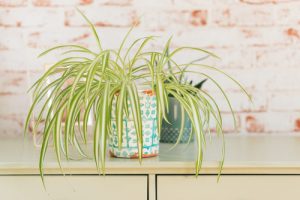
23: Spider Plant
A cute, favourite plant – and one that’s easy to grow and give to friends – is considered one of the most adaptable of houseplants and the easiest to grow. They can grow in a wide range of conditions and suffer from few problems, other than brown tips. It is named for the spider like plants – known as spiderettes, which dangle down from the mother plant like spiders on a web. Spider plant care is easy. They can tolerate a lot of abuse, making them excellent candidates for new gardeners. Give them a well-draining soil and bright, indirect light and they will flourish. Water them well but don’t allow the plants to become too soggy, as this can lead to root rot. In fact, they prefer to dry out some between waterings. Spider plants also love cooler temperatures, around 13-18°C. If your spider plant begins to brown, there is no need to worry. This is totally normal and will not harm the plant. This usually means there is more fluoride in the water, which causes salt build up in the soil.
Spider plants benefit from occasional pruning, cutting them back to the base. Since they are semi-pot bound, only repot your plant when the large, fleshy roots are highly visible and watering is difficult. They are also easily propagated by dividing the mother plant or by planting the small spiderettes. These make great gifts for friends and family!
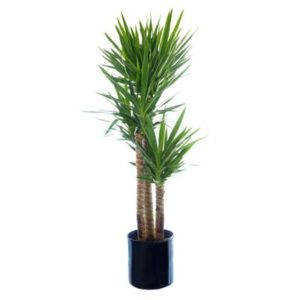
24: Yucca
Yucca plants make a great focal point in a room or as part of an attractive, indoor display. They are a great way of bringing the outdoors, indoors. Some yucca plants grow really tall, while others are on the smaller side. They prefer a sunny to partly shaded location indoors. If they are in full sun, they might for brown tips or white, necrotic spots on the leaves.
Yucca plants have low water requirements and are even somewhat drought tolerant. A little fertiliser can help establish the plant when growing yucca in containers, but won’t be needed after the plant has established itself. You can use a poor quality soil but it needs to be heavy enough to hold the plant upright. The soil also has to be well-draining. But for the best performance, the soil should retain some water and nutrients. A three to one mixture of sand and peat is a good medium for growing yucca in containers.
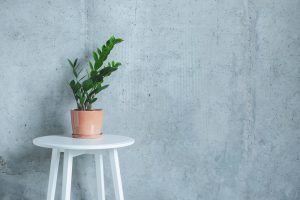
25: ZZ Plant
The ultimate plant for the worst brown thumbs has to be the ZZ plant. This virtually indestructible plant that can actually take months and months of neglect and low light, and still look amazing. Once upon a time, ZZ plants would only be found in planters in malls and large office buildings where they were easily mistaken for fake plants. But recently they have made their way into our homes and all for the better! ZZ plant stems grow in graceful, wand-like shapes with a waxy, shiny coating that makes it seem like it’s made of plastic.
ZZ plants love bright to moderate, indirect light but will do fine in extremely low levels of light. As a result, this makes for an ideal plant for a window-less office or bathroom where it will only receive small amounts of fluorescent light. If the ZZ plant is left in direct light the leaves can scald and curl up. ZZ plants do better if you leave them alone. Much like cacti, they need less rather than more water. Water the plant only when the soil has dried out but overwatering can kill your ZZ plant so be careful. A ZZ plant can go months without watering but will grow better when watered more frequently.
If you are looking for the perfect indoor plant, come into one of Aumann’s Garden Supply centres today! Our friendly staff can help you pick out the right plants for your home!


